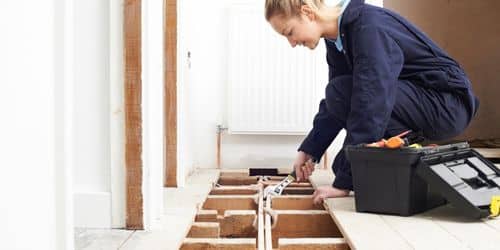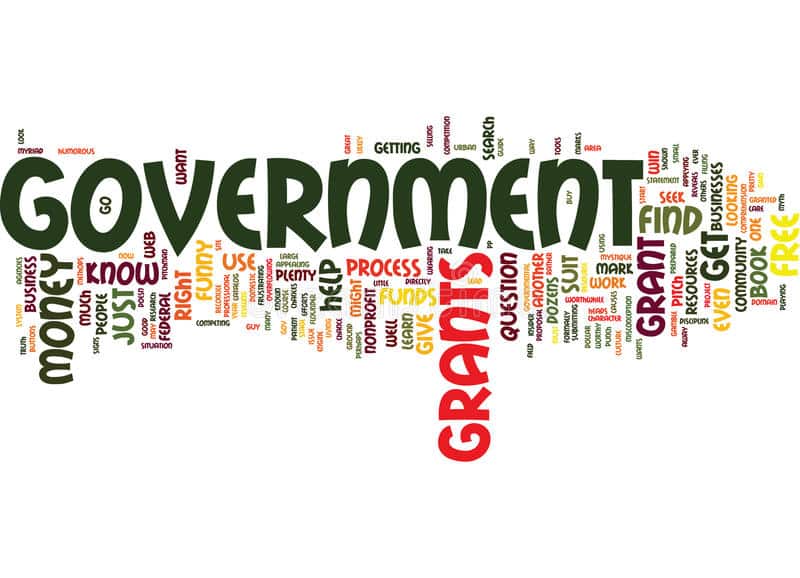There are many grants available to homeowners for repairs that may be of assistance if you require financial support for your home. The warm home discount is one of many grants available to assist people with their finances.
However, since there are also programs available in areas like making green home improvements, you don’t necessarily have to need money to benefit from a grant. Here is how to apply for grants available to homeowners that can help them increase the energy efficiency of their homes.
Grants for Homeowners for Repairs
Home improvement grants are an option for homeowners who require assistance with financing repairs to their current residence before beginning the search for their next place to live. These financial aid programs are also known as “home repair grants.” They are provided by the federal government as well as several state or local government agencies, and their goal is to help you pay for what can frequently be expensive home improvement expenses.
These grants assist homeowners in covering the costs of pricey home repairs and improvements. Grants for home improvements are intended to provide property owners with the necessary government-sponsored financial assistance. Numerous home improvement grant programs supported by the county, state, and federal governments are available as potential sources of funding, despite being extremely competitive.
These programs aren’t accessible to everyone, though, and they’re made to help with a specific kind of improvement—one that makes homes safer, more livable, and more code-compliant.
The Section 504 Home Repair Program
The US Department of Agriculture’s Single Family Housing Repair & Loan Program aims to assist families in maintaining their homes in a good condition of repair so that they can remain there, which in turn strengthens communities. The first goal of this program is to help families with extremely low incomes make repairs or improvements to their homes. The other group includes senior citizens who may need to have potential hazards or obstacles removed from their homes as well as safety features that increase accessibility and mobility installed.
Depending on your circumstances, various grants are available for homeowners to make repairs. Your neighborhood Home Improvement Agency (HIA) might be able to assist with home repairs if you’re elderly, disabled, or on a low income. This includes mounting shelves and curtains as well as performing odd jobs like fixing dripping faucets.
However, in most cases, they cover minor fixes, energy efficiency inspections like installing radiator reflectors, and home security measures like window locks and door chains. In addition to safety measures like installing carbon monoxide detectors.
Eligibility for the Program
You must be at least 62 years old and unable to repay any other type of loan to qualify for grants for the elderly. Income must be at or below 50% of the median income in the area where you live. There must be no other way for you to get credit. To repair or improve a home that you live in, you must own it.
The program’s maximum grant and loan amounts are $7,500 and $20,000, respectively, but if you qualify for both, you could receive a combined total of $27,500. Loans have a 20-year repayment term with a fixed 1% interest rate. Grants must be paid back if the grant recipient vacates the renovated property within three years of receiving the grant.
FHA’s 203(k) Rehabilitation Mortgage Insurance
For assistance with the purchase or refinance of a single-family home as well as repairs, the FHA provides 203(k) Rehabilitation Mortgage Insurance. The program covers a single, lengthy loan with a fixed or adjustable rate on homes that are at least a year old and requires no less than $5,000 in repairs, such as:
- Setting up wells
- Removing risks to safety
- Floor replacement
- Making changes to the structure
- Landscape modifications
The total value of the property cannot be greater than the FHA mortgage limits applicable in your area. The typical FHA single-family loan maximum in Georgia counties is $420,680. The 203(k) is an easy choice that protects a person from high-interest rates, making homeownership more accessible to people of all income levels.
VA Specially Adapted Housing (SAH) Grant
Veterans or disabled service members who have gone through one or more of the following circumstances are eligible for this grant:
- Having lost or lost the use of all four limbs: (1) both arms, (2) both legs, or (3) both legs and one arm.
- combined with the loss/loss of use of one leg and blindness in both eyes or with only light perception
- Having one leg lost or not functioning, along with any lingering organic illness or injury
- definite severe burn
The VA Specially Adapted Housing Grant covers the cost of buying, building, or remodeling a home to accommodate a disability. A maximum grant of $39,669 is available to those who qualify.
Free Grants for Homeowners for Repairs
#1. IDAH Home Accessibility Program
The Home Accessibility Program (HAP) of the Illinois Housing Development Authority (IDAH) aims to assist people in staying in their homes as much as possible. Seniors and people with disabilities can receive up to $25,000 from HAP to make repairs and modifications to their homes so they are livable. These funds are directly provided by the IDAH to nonprofit organizations and local institutions for distribution.
Homeowners must make at or less than 80% of the county’s median income for their household size to qualify for funding. After approval, the homeowner may use the loan for things like:
- Flooring
- Enhancements on accessibility
- Requisites for electrical or plumbing
- Replacing specific appliances
#2. CDBG Housing Rehabilitation Program
Through its Community Development Block Grant (CDBG) Housing Rehabilitation Program, the Illinois Department of Commerce and Economic Opportunity assists communities with low to moderate incomes. Communities may receive up to $550,000 in grants, or $50,000 per household, to renovate and update single-family homes. The following activities would qualify as eligible:
- Replacing the primary fixtures
- Built-in garages
- Coverage for Floods
- Accessibility attributes
#3. IDHA Single Family Rehabilitation Program
Those with low incomes can also get assistance from the IDAH to keep their homes running smoothly. A forgivable loan of up to $45,000 is available through the Single Family Rehabilitation Program to owner-occupied homes with household incomes at or below 80% of the local median. The grants cover the costs of replacing things like:
- Cabinetry
- HVAC
- Faulty appliances
- Working appliances, luxury upgrades, and upgrades above market value are not eligible.
- Stairs
A forgivable loan of up to $16,500 is also available through the program for roof-only repairs of roofs, downspouts, and related structures.
After receiving thorough documentation on repairs, eligible households submit applications through their local governments and nonprofit organizations.
#4. USDA Rural Development Single Family Housing Repair Loans & Grants
Through its Section 504 Home Repair Program, the USDA Rural Development helps rural communities all over the United States modernize buildings and build modern, affordable housing. Low-income people can borrow up to $40,000 at 1% interest for 20 years thanks to this program. But homeowners 62 years of age and up can receive grants of up to $10,000.
To qualify, a homeowner must live in a rural area that is allowed, not be able to afford credit, and earn no more than the county’s extremely low limit.
While the grants are focused on removing health hazards, homeowners can carry out repairs, modernize, and improve their homes using a USDA Home Repair Loan. The state’s RD office is where candidates must submit their applications, and they must work with a USDA home loan specialist.
What to Do With a House You Can’t Afford to Fix?
#1. Apply for a HELOC
You can get the funding you require for larger repairs by applying for a home equity line of credit (HELOC). Your home’s equity serves as security for the credit line. Lenders determine your eligibility by looking at your income, equity in your home, and credit score, which should ideally be greater than 620. Typically, you have 10 years to access your money and another 20 years to pay off the balance.
#2. Apply for a Home Repair Loan
Your credit history and available income will be the primary determining factors for most home improvement loans. Furthermore, the average repayment period for these loans is less than ten years. This could be a good option if you don’t have enough equity to qualify for a cash-out refinance or a HELOC. Additionally, this may be a good choice if you want to make less costly, smaller repairs because you’ll have time to pay them off.
#3. Make Use of a Non-profit Community Development Initiative.
The Community Development Block Grant Program is governed by the United States Department of Housing and Urban Development (HUD). Their goal is to revitalize urban areas by giving residents access to the resources they need to enhance housing conditions.
#4. Research Grants and Loans From the Government.
Several government agencies offer numerous loans and grants for repairs. They frequently offer low-income homeowners more options, like zero- or low-interest loans, that may not be accessible through conventional loans. Need, income, creditworthiness, and the amount of debt owed are typically used to determine each program’s prerequisites. Grants frequently don’t require repayment unless the homeowner sells their home sooner than anticipated.
How Do I Find My Local Grants?
Use the free, government-run website Grants.gov to look for or apply for grants. Grants.gov serves as a hub for data from more than 1,000 government grant programs. Its goal is to make finding and applying for grants easier for organizations and states.
Is the Government Giving Grants for Home Improvements?
Home repairs and modifications can be financed through loan programs for home improvements. They represent the most typical form of government funding for home improvements. While some programs are accessible on a national level, others are only accessible at the state or local level.
What Should You Do if the Value of Your Home Exceeds What You Owe?
#1. Sell Your House
Selling might be the best course of action for older homeowners who want to downsize to a smaller home, a condo, or 55+ living. If the timing is right and you are certain that you want to move to a market with lower housing costs, it might also be the best option for homeowners.
#2. Get an Appraisal on Your House to Avoid Mortgage Insurance
If you paid less than 20% of the price for the property when you bought it, private mortgage insurance (PMI) is typically added to your monthly mortgage payment. In case you default, PMI will protect your creditors. However, if the value of your house suddenly increases, you might have enough equity to ask to have the PMI canceled. You will need to pay for a home appraisal to prove to lenders that the value of the house has increased.
#3. Take Equity Out
Considering how low-interest rates are, another choice is to withdraw some equity. A home equity line of credit (HELOC) or a cash-out refinance, in which you withdraw the equity in actual cash, are two options for taking equity out. Reverse mortgages, which allow homeowners to access the equity in their homes, are also available to those who are at least 62 years old.
Can You Get an Extra Mortgage for Repairs?
Yes, without a doubt. Taking out a second mortgage to pay for major home improvements like a kitchen remodel, a loft addition, or a portion of your home renovation is fairly common. Even though they will increase the value of your home enough to cover their costs if you decide to sell it later, home improvements can be extremely expensive.
What Is a Type 5 Grant?
A Type 5 grant is a non-competing continuation. Request or award for a later budget period of a previously approved project, where the recipient is exempt from competition. It continues to provide support during the grant’s expiration years and doesn’t bid for money. There is no competition between Type 5 and other applications.
What Is the Home Upgrade Grant?
Homeowners and private renters can both benefit from the Home Upgrade Grant (HUG), which helps them make their homes more energy efficient. The Local Authority Delivery program of the government provides funding for HUG. You can make long-term financial savings using this grant for energy upgrades. The grant pays all or a portion of the installation costs for the following types of insulation:
- Insulation for lofts
- Draught proofing
- Insulation for cavity walls
- Room-in-roof insulation
How Much Will I Receive Under the Grant?
The survey and insulation work are entirely covered by homeowners’ Home Upgrade Grants. For insulation improvements, private tenants may be eligible for a grant of up to £5,000. The landlord is required to cover at least one-third of the expense.
Do I Qualify for the Home Upgrade Grant?
You can only get free insulation if you live in a house in York, Harrogate, Craven, or Selby. You must either receive government assistance or have a household income of less than £30,000. Every grant is subject to eligibility verification and a home survey.
Who Is Eligible for the Special Support Grant?
You may receive housing assistance or the housing component of universal credit. A disability qualifies you for an employment support allowance based on your income.
Conclusion
To ensure that low-income communities’ homes are secure and modern, home repair grant programs are essential.
There are government-sponsored programs that can assist those who meet the requirements if they have a house that needs repair. These grants aren’t for homeowners who just want to remodel; they’re for those who genuinely need them. These grants are intended to assist residents of the community in finding a secure and sanitary home for themselves and their families.
Learn all the requirements for eligibility before you apply for a grant, and gather any supporting documentation you might need. Be aware that some grants may have restrictions and that typically only the most qualified applicants are chosen. Then, exercise patience because it might take some time for the government to collect the funds before paying you
Grants For Homeowners FAQS
What Are Grants for Homeowners?
Home improvement grants are an option for homeowners who require assistance with financing repairs to their current residence before beginning the search for their next place to live
Can You Get an Extra Mortgage for Repairs?
What Is a Type 5 Grant?
A Type 5 grant is a non-competing continuation. Request or award for a later budget period of a previously approved project, where the recipient is exempt from competition.
Related Articles
- 203K Loan: FHA Loan Requirements for 2023
- BEST HOME IMPROVEMENT LOAN IN 2023
- Financing Home Improvements: Options for Financing Home Improvements
- Owner, Check Out 5 Tips On How To Rent Your Property!
- NEW HOMEOWNERS TAX CREDIT: What It is And The Eligibility(
- Grants: Definition, Types, Examples And Eligibility






